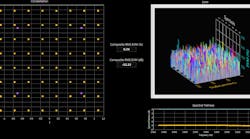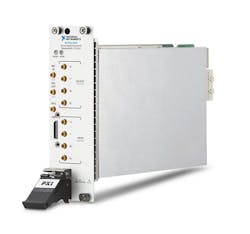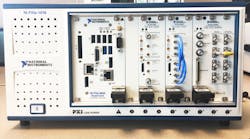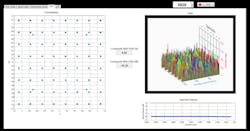Download this article as a .PDF
Last year, National Instruments (NI) made headlines by introducing the PXIe-5840, the company’s second-generation vector signal transceiver (VST; see "RF Measurement Modularity Redefined." Covering a frequency range of 9 kHz to 6 GHz, the PXIe-5840 can achieve 1 GHz of instantaneous bandwidth. Not resting on its laurels, NI again made news earlier this year by unveiling the PXIe-5820 baseband VST (Fig. 1).
The PXIe-5820 baseband VST can achieve 1 GHz of in-phase/quadrature (I/Q) instantaneous bandwidth for generation and analysis. The new VST combines a wideband I/Q digitizer, wideband I/Q arbitrary waveform generator (AWG), and user-programmable field-programmable gate array (FPGA) into a single instrument. Furthermore, this capability is all contained in a single two-slot PXI Express module.
The PXIe-5820 is well suited to meet the needs of next-generation wireless communications, such as 5G and IEEE 802.11ax. Specifically, the PXIe-5820 VST can achieve an error vector magnitude (EVM) of better than -54 dB when utilizing the IEEE 802.11ax 1024-QAM modulation scheme.
A key benefit of the PXIe-5820 is that it can be synchronized with the PXIe-5840 RF VST to sub-nanosecond accuracy. Thus, both VSTs can be used in combination to create a complete test solution for RF and baseband differential I/Q testing of wireless chipsets. Envelope tracking (ET) and digital pre-distortion (DPD) power amplifier (PA) techniques are supported by the VST test solution. Moreover, the PXIe-5820 includes a number of LabVIEW sample projects.
5G Measurement Example
NI’s VST test solution allows for the generation and analysis of potential 5G waveforms. Figure 2 shows a PXI chassis that contains both the PXIe-5840 RF VST and the PXIe-5820 baseband VST. The PXIe-5820 is configured in loopback mode, meaning that its I/Q input and output ports are connected to each other via cables. The PXIe-5840 can also configured be in loopback mode, meaning that its RF input and output ports are similarly connected to each other with a cable.
Figure 3 shows the spectrum of a potential 5G waveform that was created by operating the PXIe-5820 in loopback mode. The figure shows four 100-MHz carriers, resulting in a total bandwidth of 400 MHz. This same functionality can be implemented in the RF VST by selecting the RF model (top right of Fig. 3).
In addition to spectral analysis, the VST test setup allows EVM measurements to be performed by selecting the EVM tab. Figure 4 shows the PXIe-5820 VST achieving an EVM of less than -52 dB. Again, the same measurements could also be performed using the RF VST.
To sum up, the PXIe-5820 baseband VST is just the latest innovative product from NI. It offers industry-first capabilities and continues to demonstrate NI’s position with regard to next-generation wireless technology.





